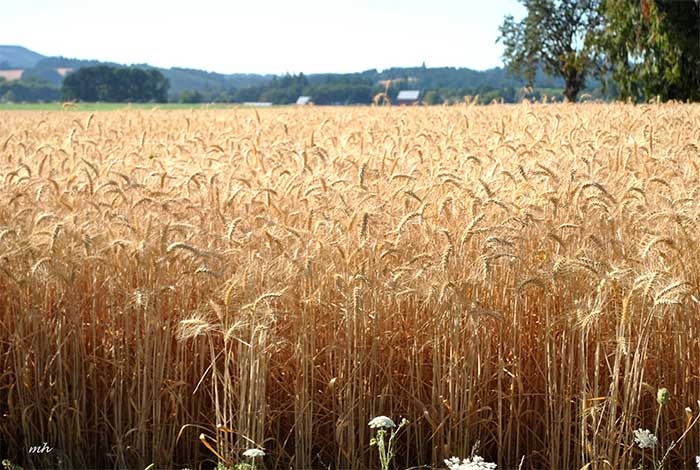One hundred years ago, plant scientist Arthur Watkins initiated a remarkable project. He painstakingly collected wheat samples from around the world.
Watkins’ perseverance was extraordinary, and a century later, it is about to yield astonishing results. A collaborative project between the UK and China has sequenced the DNA of all 827 wheat varieties collected by Watkins, which have been nurtured at the John Innes Centre near Norwich for most of the past century.
A Treasure Trove of Wheat Genetic Resources
In doing so, scientists have formed a treasure trove of genetic material by identifying previously unknown genes. Many of these are being utilized to develop robust wheat varieties with improved yields that could help feed the growing population on Earth.
The strains currently being developed include wheat that can grow in saline soils, while researchers at Punjab Agricultural University are working to enhance disease resistance from the seeds they received from the John Innes Centre. Other strains may reduce the need for nitrogen fertilizers, which is significant because nitrogen fertilizer production is a major source of carbon emissions.
Simon Griffiths, a geneticist at the John Innes Centre and co-leader of the project, stated: “Essentially, we have discovered a gold mine. This will make a huge difference to the ability to supply food for the world as temperatures rise and agriculture faces increasing pressure from climate change.”

Wheat originated from wild grass varieties that were domesticated about 10,000 years ago.
Today, one in every five calories consumed by humans comes from wheat, and each year, more people are eating wheat as the world’s population continues to grow.
Griffiths added: “Wheat is the foundation of human civilization. In areas such as Europe, North Africa, many vast regions of Asia, and later North America, wheat cultivation has sustained great empires, from ancient Egypt to the development of modern Britain.”
This wheat traces back to original wild grass varieties that were domesticated and cultivated in the Fertile Crescent of the Middle East, around 10,000 years ago. Many of these wheat varieties and their genes have disappeared. Unfortunately, this process accelerated about a century ago as plant breeding science advanced. During that time, some wheat strains were deemed worthless and were discarded.
Griffiths explained: “That is why the Watkins collection is so important. This collection contains lost varieties that will be immensely valuable in creating wheat that can deliver promising yields under the harsh climate conditions that currently threaten agriculture.”
Too Complex and Expensive, So Chinese Scientists Decoded It on a Hard Drive
Co-leader of the project, Shifeng Cheng, a professor at the Chinese Academy of Agricultural Sciences, stated: “We can rediscover the novel, valuable, and useful diversity that was lost in modern wheat after the ‘Green Revolution’ in the 20th century and have the opportunity to reintroduce it into breeding programs.”
The scientists aimed to identify and study wheat genes in the Watkins collection after developing large-scale DNA sequencing over a decade ago, but they faced an unusual challenge. The wheat genome is vast: it consists of 17 billion DNA units, nearly six times the 3 billion base pairs that make up the human genome.
Griffiths said: “The wheat genome is filled with sophisticated factors, making sequencing more challenging and costly. However, thanks to our Chinese colleagues who performed detailed sequencing work, we were able to overcome that issue.”
Griffiths and his colleagues sent samples from the Watkins collection to Cheng and received a response three months later with a suitcase full of hard drives. These hard drives contained a petabyte of data equivalent to 1,000 terabytes or 1 million gigabytes—data that the Chinese scientists had decoded from the Watkins collection.
Astonishingly, this data revealed that modern wheat varieties utilize only 40% of the genetic diversity present in the collection.
Griffiths noted: “We discovered that the Watkins collection is filled with useful variants that modern wheat lacks.”
These lost traits are currently being experimented with by plant breeders aiming to create a range of new varieties that may have been forgotten without Arthur Watkins’ efforts.
Arthur Watkins had an unusual introduction to agriculture. At 19, he was sent to the battlefield in World War I. He survived, and for months after the armistice, he was ordered to stay in France as an agricultural officer, tasked with helping local farmers supply food to soldiers still waiting to return home.
Simon Griffiths stated that this role sparked Watkins’ interest in agriculture, and upon returning to England, he applied to study the subject at Cambridge. After graduation, Watkins joined the agricultural faculty at Cambridge, where he began a lifelong endeavor: collecting wheat samples from across the globe.
Griffiths remarked: “What’s important is that Watkins recognized that when we start breeding new wheat varieties, genes that were considered less useful and were discarded could still hold value in the future.”
“His thinking was remarkably ahead of its time. He realized that genetic diversity—in this case, of wheat—was being eroded, and we needed to stop that.”
“Very few scientists thought about this issue back then. Watkins clearly thought well ahead of his time, and future generations owe a debt of gratitude for that.”


















































